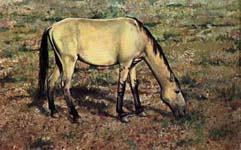 Now recognized as the primitive ancestor of the Iberian Saddle Horse, the Spanish Sorraia is still found in the foothills of the Sierra de San Mamede in Portugal today. The Sorraia bears the strong dominant genes of the sub-convex profile, the high trotting action, and the close coupled compact body of his modern descendants. Except for the profile, the Sorraia resembles the
Tarpan, which is the prehistoric ancestor of the Indo-European domesticated horse. The Sorraia is one of the six types of original wild horse known to man.
Now recognized as the primitive ancestor of the Iberian Saddle Horse, the Spanish Sorraia is still found in the foothills of the Sierra de San Mamede in Portugal today. The Sorraia bears the strong dominant genes of the sub-convex profile, the high trotting action, and the close coupled compact body of his modern descendants. Except for the profile, the Sorraia resembles the
Tarpan, which is the prehistoric ancestor of the Indo-European domesticated horse. The Sorraia is one of the six types of original wild horse known to man.
He takes his name from the Rivers Sor and Raia, which are small tributaries of the Sorraia which waters the plains where these horses are bred. He is extremely hardy and noted for his ability to survive on very little and poor quality food. The Sorraia rarely exceeds 13.2 hands. Due to his tough and wiry constitution, he is popular with local stockmen, and has been the mount of local cowboys for centuries. Today the breed is maintained as a pure herd by the d'Andrade family for national interest and for zoological and genetic research worldwide. Many historians now believe that the Sorraia played a greater part in the ancestry of the
mustangs of South America than the more refined
Andalusian.
The interesting color of the Sorraia is a distinctive yellow or mustard
dun, or mouse grey with black dorsal stripe, black-tipped ears and a heavy, luxuriant black mane and tail, often streaked with the blonde or mouse color of the main body. There are invariably zebra stripes on the legs and in the summer the coat lightens, pale spots often apparent on the belly. It is evident that there has been no introduction at any time of Oriental or northern European blood into the Sorraia's ancestry, which helps to show the influence of other genes used to refine the Iberian Saddle Horse.
For more information on the Sorraia, visit:
Published August 2000 in the NorthWest Breyer Horse Club newsletter. (em)

|
© 1994-2018 NW Breyer Horse Club
& Refiner of Gold Creations
Equinealities in place since 1997,
Section in place 2001,
Updated 2/19/2018
|



|
|

|
 Now recognized as the primitive ancestor of the Iberian Saddle Horse, the Spanish Sorraia is still found in the foothills of the Sierra de San Mamede in Portugal today. The Sorraia bears the strong dominant genes of the sub-convex profile, the high trotting action, and the close coupled compact body of his modern descendants. Except for the profile, the Sorraia resembles the
Tarpan, which is the prehistoric ancestor of the Indo-European domesticated horse. The Sorraia is one of the six types of original wild horse known to man.
Now recognized as the primitive ancestor of the Iberian Saddle Horse, the Spanish Sorraia is still found in the foothills of the Sierra de San Mamede in Portugal today. The Sorraia bears the strong dominant genes of the sub-convex profile, the high trotting action, and the close coupled compact body of his modern descendants. Except for the profile, the Sorraia resembles the
Tarpan, which is the prehistoric ancestor of the Indo-European domesticated horse. The Sorraia is one of the six types of original wild horse known to man.





